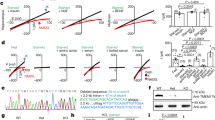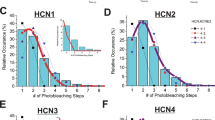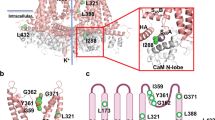Abstract
The small-conductance calcium-activated K+ channel SK3 (SKCa3/KCNN3) regulates electrical excitability and neurotransmitter release in monoaminergic neurons, and has been implicated in schizophrenia, ataxia and anorexia nervosa. We have identified a novel SK3 transcript, SK3-1B that utilizes an alternative first exon (exon 1B), but is otherwise identical to SK3. SK3-1B, mRNA is widely distributed in human tissues and is present at 20–60% of SK3 in the brain. The SK3-1B protein lacks the N-terminus and first transmembrane segment, and begins eight residues upstream of the second transmembrane segment. When expressed alone, SK3-1B did not produce functional channels, but selectively suppressed endogenous SK3 currents in the pheochromocytoma cell line, PC12, in a dominant-negative fashion. This dominant inhibitory effect extended to other members of the SK subfamily, but not to voltage-gated K+ channels, and appears to be due to intracellular trapping of endogenous SK channels. The effect of SK3-1B expression is very similar to that produced by expression of the rare SK3 truncation allele, SK3-Δ, found in a patient with schizophrenia. Regulation of SK3 and SK3-1B levels may provide a potent mechanism to titrate neuronal firing rates and neurotransmitter release in monoaminergic neurons, and alterations in the relative abundance of these proteins could contribute to abnormal neuronal excitability, and to the pathogenesis of schizophrenia.
This is a preview of subscription content, access via your institution
Access options
Subscribe to this journal
Receive 12 print issues and online access
$259.00 per year
only $21.58 per issue
Buy this article
- Purchase on Springer Link
- Instant access to full article PDF
Prices may be subject to local taxes which are calculated during checkout






Similar content being viewed by others
References
Storm JF . Potassium currents in hippocampal pyramidal cells. Prog Brain Res 1990; 83: 161–187.
Sah P . Ca2+-activated K+ currents in neurones: types, physiological roles and modulation. Trends Neurosci 1996; 19: 150–154.
Ishii TM, Maylie J, Adelman JP . Determinants of apamin and d-tubocurarine block in SK potassium channels. J Biol Chem 1997; 272: 23195–23200.
Koronyo-Hamaoui M, Danziger Y, Frisch A, Stein D, Leor S, Laufer N et al. Association between anorexia nervosa and the hsKCa3 gene: a family-based and case control study. Mol Psychiatry 2002; 7: 82–85.
Figueroa KP, Chan P, Schols L, Tanner C, Riess O, Perlman SL et al. Association of moderate polyglutamine tract expansions in the slow calcium-activated potassium channel type 3 with ataxia. Arch Neurol 2001; 58: 1649–1653.
Dror V, Shamir E, Ghanshani S, Kimhi R, Swartz M, Barak Y et al. hKCa3/KCNN3 potassium channel gene: association of longer CAG repeats with schizophrenia in Israeli Ashkenazi Jews, expression in human tissues and localization to chromosome 1q21. Mol Psychiatry 1999; 4: 254–260.
Brzustowicz LM, Hodgkinson KA, Chow EW, Honer WG, Bassett AS . Location of a major susceptibility locus for familial schizophrenia on chromosome 1q21–q22. Science 2000; 288: 678–682.
Ekelund J, Hovatta I, Parker A, Paunio T, Varilo T, Martin R et al. Chromosome 1 loci in Finnish schizophrenia families. Hum Mol Genet 2001; 10: 1611–1617.
Gurling HMD, Kalsi G, Brynjohlfson J, Sigmundsson T, Sherrington R, Mankoo BS et al. Genomewide genetic linkage analysis confirms the presence of susceptibility loci for schizophrenia, on chromosomes 1q32.2, 5q33.2, and 8p21-22 and provides support for linkage to schizophrenia, on chromosomes 11q23.3–24 and 20q12.1–11.23. Am J Hum Genet 2001; 68 661–673.
Ducros A, Joutel A, Vahedi K, Cecillon M, Ferreira A, Bernard E et al. Mapping of a second locus for familial hemiplegic migraine to 1q21–q23 and evidence of further heterogeneity. Ann Neurol 1997; 42: 885–890.
Cevoli S, Pierangeli G, Monari L, Valentino ML, Bernardoni P, Mochi M et al. Familial hemiplegic migraine: clinical features and probable linkage to chromosome 1 in an Italian family. Neurol Sci 2002; 23: 7–10.
Farde L . Brain imaging of schizophrenia—the dopamine hypothesis. Schizophr Res 1997; 28: 157–162.
Csernansky JG, Csernansky CA, Kogelman L, Montgomery EM, Bardgett ME . Progressive neurodegeneration after intracerebroventricular kainic acid administration in rats: Implications for schizophrenia? Biol Psychiatry 1998; 44: 1143–1150.
Laruelle M, Abi-Dargham P . Dopamine as the wind of the psychotic fire: new evidence from brain imaging studies. J Psychopharmacol 1999; 13: 358–371.
Heckers S . Neuroimaging studies of the hippocampus in schizophrenia. Hippocampus 2001; 11: 520–528.
Nopoulos PC, Ceilley JW, Gailis EA, Andreasen NC . An MRI study of midbrain morphology in patients with schizophrenia: relationship to psychosis, neuroleptics, and cerebellar neural circuitry. Biol Psychiatry 2001; 49: 13–19.
Meyer-Lindenberg A, Miletich RS, Kohn PD, Esposito G, Carson RE, Quarantelli M et al. Reduced prefrontal activity predicts exaggerated striatal dopaminergic function in schizophrenia. Nat Neurosci 2002; 5: 267–271.
Stocker M, Pedarzani P . Differential distribution of three Ca2+-activated K+ channel subunits, SK1, SK2, and SK3, in the adult rat central nervous system. Mol Cell Neurosci 2000; 15: 476–493.
Rimini R, Rimland JM, Terstappen GC . Quantitative expression analysis of the small conductance calcium-activated potassium channels, SK1, SK2 and SK3, in human brain. Brain Res 2000; 85: 218–220.
Wolfart J, Neuhoff H, Franz O, Roeper J . Differential expression of the small-conductance, calcium-activated potassium channel SK3 is critical for pacemaker control in dopaminergic midbrain neurons. J Neurosci 2001; 21: 3443–3456.
Stocker M, Krause M, Pedarzani P . An apamin-sensitive Ca2+-activated K+ current in hippocampal pyramidal neurons. Proc Natl Acad Sci USA 1999; 96: 4662–4667.
Savic N, Pedarzani P, Sciancalepore M . Medium afterhyperpolarization and firing pattern modulation in interneurons of stratum radiatum in the CA3 hippocampal region. J Neurophysiol 2001; 85: 1986–1997.
Pedarzani P, Mosbacher J, Rivard A, Cingolani LA, Oliver D, Stocker M et al. Control of electrical activity in central neurons by modulating the gating of small conductance Ca2+-activated K+ channels. J Biol Chem 2001; 276: 9762–9769.
Steketee JD, Kalivas PW . Effect of microinjections of apamin into the A10-dopamine region of rats—a behavioral and neurochemical analysis. J Pharmacol Exp Ther 1990; 254: 711–719.
Shepard PD, Bunney BS . Effects of apamin on the discharge properties of putative dopamine-containing neurons in vitro. Brain Res 1988; 463: 380–384.
Ping HX, Shepard PD . Apamin-sensitive Ca2+-activated K+ channels regulate pacemaker activity in nigral dopamine neurons. Neuroreport 1996; 7: 809–814.
Chandy KG, Fantino E, Wittekindt O, Kalman K, Tong LL, Ho TH et al. Isolation of a novel potassium channel gene hSKCa3 containing a polymorphic CAG repeat: a candidate for schizophrenia and bipolar disorder? Mol Psychiatry 1998; 3: 32–37.
Bowen T, Guy CA, Craddock N, Cardno AG, Williams NM, Spurlock G et al. Further support for an association between a polymorphic CAG repeat in the hKCa3 gene and schizophrenia. Mol Psychiatry 1998; 3: 266–269.
Wittekindt O, Jauch A, Burgert E, Scharer L, Holtgreve-Grez H, Yvert G et al. The human small conductance calcium-regulated potassium channel gene (hSKCa3) contains two CAG repeats in exon 1, is on chromosome 1q21.3, and shows a possible association with schizophrenia. Neurogenetics 1998; 1: 259–265.
Cardno AG, Bowen T, Guy CA, Jones LA, McCarthy G, Williams NM et al. CAG repeat length in the hKCa3 gene and symptom dimensions in schizophrenia. Biol Psychiatry 1999; 45: 1592–1596.
O'Donovan MC, Owen MJ . Candidate-gene association studies of schizophrenia. Am J Hum Genet 1999; 65: 587–592.
Ritsner M, Modai I, Amir S, Halperin T, Weizman A et al. An association of CAG repeats at the KCNN3 locus with symptom dimensions of schizophrenia. Biol Psychiatry 2002; 51: 788–794.
Antonarakis SE, Blouin JL, Lasseter VK, Gehrig C, Radhakrishna U, Nestadt G et al. Lack of linkage or association between schizophrenia and the polymorphic trinucleotide repeat within the KCNN3 gene on chromosome 1q21. Am J Med Genet 1999; 88: 348–351.
Joober R, Benkelfat C, Brisebois K, Toulouse A, Lafreniere RG, Turecki G et al. Lack of association between the hSKCa3 channel gene CAG polymorphism and schizophrenia. Am J Med Genet 1999; 88: 154–157.
Bonnet-Brilhault F, Laurent C, Campion D, Thibaut F, Lafargue C, Charbonnier F et al. No evidence for involvement of KCNN3 (hSKCa3) potassium channel gene in familial and isolated cases of schizophrenia. Eur J Hum Genet 1999; 7: 247–250.
Hawi Z, Mynett-Johnson L, Murphy V, Straub RE, Kendler KS, Walsh D et al. No evidence to support the association of the potassium channel gene hSKCa3 CAG repeat with schizophrenia or bipolar disorder in the Irish population. Mol Psychiatry 1999; 4: 488–491.
Tsai MT, Shaw CK, Hsiao KJ, Chen CH . Genetic association study of a polymorphic CAG repeats array of calcium-activated potassium channel (KCNN3) gene and schizophrenia among the Chinese population from Taiwan. Mol Psychiatry 1999; 4: 271–273.
Chowdari KV, Wood J, Ganguli R, Gottesman II, Nimgaonkar VL . Lack of association between schizophrenia and a CAG repeat polymorphism of the hSKCa3 gene in a north eastern US sample. Mol Psychiatry 2000; 5: 237–238.
Stober G, Meyer J, Nanda I, Wienker TF, Saar K, Jatzke S et al. hKCNN3 which maps to chromosome 1q21 is not the causative gene in periodic catatonia, a familial subtype of schizophrenia. Eur Arch Psychiatry Clin Neurosci 2000; 250: 163–168.
Ujike H, Yamamoto A, Tanaka Y, Takehisa Y, Takaki M, Taked T et al. Association study of CAG repeats in the KCNN3 gene in Japanese patients with schizophrenia, schizoaffective disorder and bipolar disorder. Psychiatry Res 2001; 101: 203–207.
Bowen T, Williams N, Norton N, Spurlock G, Wittekindt OH, Morris-Rosendahl DJ et al. Mutation screening of the KCNN3 gene reveals a rare frameshift mutation. Mol Psychiatry 2001; 6: 259–260.
Miller MJ, Rauer H, Tomita H, Rauer H, Gargus JJ, Gutman GA et al. Nuclear localization and dominant-negative suppression by a mutant SKCa3 N-terminal channel fragment identified in a patient with schizophrenia. J Biol Chem 2001; 276: 27753–27756.
Dawson LA, Routledge C . Differential effects of potassium channel blockers on extracellular concentrations of dopamine and 5-HT in the striatum of conscious rats. Br J Pharmacol 1995; 116: 3260–3264.
Bardien-Kruger S, Wulff H, Arieff Z, Brink P, Chandy KG, Corfield V . Characterisation of the human voltage-gated potassium channel gene, KCNA7, a candidate gene for inherited cardiac disorders, and its exclusion as cause of progressive familial heart block I (PFHBI). Eur J Hum Genet 2002; 10: 36–43.
Tu L, Santarelli V, Sheng Z, Skach W, Pain D, Deutsch C . Voltage-gated K+ channels contain multiple intersubunit association sites. J Biol Chem 1996; 271: 18904–18911.
Joiner WJ, Khanna R, Schlichter LC, Kaczmarek LK . Calmodulin regulates assembly and trafficking of SK4/IK1 Ca2+-activated K+ channels. J Biol Chem 2001; 276: 37980–37985.
Fanger CM, Rauer H, Neben AL, Miller MJ, Rauer H, Wulff H et al. Calcium-activated potassium channels sustain calcium signaling in T lymphocytes. J Biol Chem 2001; 276: 12249–12256.
Deutsch C . Potassium channel ontogeny. Annu Rev Physiol 2002; 64: 19–46.
Doyle DA, Morais Cabral J, Pfuetzner RA, Kuo A, Gulbis JM, Cohen SL et al. The structure of the potassium channel: molecular basis of K+ conduction and selectivity. Science 1998;280: 69–77.
Jiang YX, Lee A, Chen JY, Cadene M, Chait BT, MacKinnon R . The open pore conformation of potassium channels. Nature 2002; 417: 523–526.
Schumacher MA, Rivard AF, Bachinger HP, Adelman JP . Structure of the gating domain of a Ca2+-activated K+ channel complexed with Ca2+/calmodulin. Nature 2001; 410: 1120–1124.
Jiang YX, Lee A, Chen JY, Cadene M, Chait BT, MacKinnon R . Crystal structure and mechanism of a calcium-gated potassium channel. Nature 2002; 417: 515–522.
Sun G, Tomita H, Shakkottai VG, Gargus JJ . Genomic organization and promoter analysis of human KCNN3 gene. J Hum Genet 2001; 46: 463–470.
Wulff H, Gutman GA, Cahalan MD, Chandy KG . Delineation of the clotrimazole/TRAM-34 binding site on the intermediate conductance calcium-activated potassium channel, IKCa1. J Biol Chem 2001; 276: 32040–32045.
Shakkottai VG, Regaya I, Wulff H, Fajloun Z, Tomita H, Fathallah M et al. Design and characterization of a highly selective peptide inhibitor of the small conductance calcium-activated K+ channel, SkCa2. J Biol Chem 2001; 276: 43145–43151.
Grissmer S, Lewis RS, Cahalan MD . Ca2+-activated K+ channels in human leukemic T cells. J Gen Physiol 1992; 99: 63–84.
Desai R, Peretz A, Idelson H, Lazarovici P, Attali B . Ca2+-activated K+ channels in human leukemic jurkat T cells. Molecular cloning, biochemical and functional characterization. J Biol Chem 2000; 275: 39954–39963.
Southan C . A genomic perspective on human proteases. FEBS Lett 2001; 498: 214–218.
Brett D, Pospisil H, Valcarel J, Reich J, Bork P . Alternative splicing and genome complexity. Nat Genet 2002; 30: 29–30.
Shalaby FY, Levesque PC, Yang WP, Little WA, Conder ML, Jenkins-West T et al. Dominant-negative KvLQT1 mutations underlie the LQT1 form of long QT syndrome. Circulation 1997; 96: 1733–1736.
Kagan A, Yu Z, Fishman GI, McDonald TV . The dominant negative LQT2 mutation A561V reduces wild-type HERG expression. J Biol Chem 2000; 275: 11241–11248.
Schroeder BC, Kubisch C, Stein V, Jentsch TJ . Moderate loss of function of cyclic-AMP-modulated KCNQ2/KCNQ3 K+ channels causes epilepsy. Nature 1998; 396: 687–690.
Jiang M, Tseng-Crank J, Tseng GN . Suppression of slow delayed rectifier current by a truncated isoform of KvLQT1 cloned from normal human heart. J Biol Chem 1997; 272: 24109–24112.
Demolombe S, Baro I, Pereon Y, Bliek J, Mohammad-Panah R, Pollard H et al. A dominant negative isoform of the long QT syndrome 1 gene product. J Biol Chem 1998; 273: 6837–6843.
Smith JS, Iannotti CA, Dargis P, Christian EP, Aiyar J . Differential expression of kcnq2 splice variants: implications to m current function during neuronal development. J Neurosci 2001; 21: 1096–1103.
Hugnot JP, Salinas M, Lesage F, Guillemare E, de Weille J, Heurteaux C et al. Kv8.1, a new neuronal potassium channel subunit with specific inhibitory properties towards Shab and Shaw channels. EMBO J 1996; 15: 3322–3331.
Salinas M, Duprat F, Heurteaux C, Hugnot JP, Lazdunski M . New modulatory alpha subunits for mammalian Shab K+ channels. J Biol Chem 1997; 272: 24371–24379.
Raghib A, Bertaso F, Davies A, Page KM, Meir A, Bogdanov Y et al. Dominant-negative synthesis suppression of voltage-gated calcium channel cav2.2 induced by truncated constructs. J Neurosci 2001; 21: 8495–8504.
Hovanes K, Li TW, Munguia JE, Truong T, Milovanovic T, Lawrence Marsh J et al. Beta-catenin-sensitive isoforms of lymphoid enhancer factor-1 are selectively expressed in colon cancer. Nat Genet 2001; 28: 3–4.
Chelli M, Alizon M . Determinants of the trans-dominant negative effect of truncated forms of the CCR5 Chemokine Receptor. J Biol Chem 2001; 276: 46975–46982.
Tiffoche C, Vaillant C, Schausi D, Thieulant ML . Novel intronic promoter in the rat ER alpha gene responsible for the transient transcription of a variant receptor. Endocrinology 2001; 142: 4106–4119.
Gil J, Rullas J, Garcia MA, Alcami J, Esteban M . The catalytic activity of dsRNA-dependent protein kinase, PKR, is required for NF-kappaB activation. Oncogene 2001; 20: 385–394.
Shepard PD, Bunney BS . Repetitive firing properties of putative dopamine-containing neurons invitro—regulation by an apamin-sensitive Ca2+-activated K+ conductance. Exp Brain Res 1991; 86: 141–150.
Author information
Authors and Affiliations
Corresponding author
Rights and permissions
About this article
Cite this article
Tomita, H., Shakkottai, V., Gutman, G. et al. Novel truncated isoform of SK3 potassium channel is a potent dominant-negative regulator of SK currents: implications in schizophrenia. Mol Psychiatry 8, 524–535 (2003). https://doi.org/10.1038/sj.mp.4001271
Received:
Revised:
Accepted:
Published:
Issue Date:
DOI: https://doi.org/10.1038/sj.mp.4001271
Keywords
This article is cited by
-
Channelopathy of small- and intermediate-conductance Ca2+-activated K+ channels
Acta Pharmacologica Sinica (2023)
-
Antidepressant activity of pharmacological and genetic deactivation of the small-conductance calcium-activated potassium channel subtype-3
Psychopharmacology (2022)
-
Amygdalocortical Circuitry in Schizophrenia: From Circuits to Molecules
Neuropsychopharmacology (2010)
-
Functions and Modulation of Neuronal SK Channels
Cell Biochemistry and Biophysics (2009)
-
The expression and function of Ca2+‐sensing receptors in rat mesenteric artery; comparative studies using a model of type II diabetes
British Journal of Pharmacology (2008)



